Colchester, Essex
Up to 1834
In 1698, following the example of Bristol two years before, Colchester successfully promoted a private Act of Parliament (9 William III, c.37) for the "erection of hospitals and workhouses for better employing and maintaining the poor."
In 1725, the SPCK's "An Account of Several Work-houses..." reported that:
From among these forty eight, are chose by them selves a Governour, Deputy Governour, Treasurer, and twelve Assistants. The Business of these last, is to have the immediate Direction and Management of the Poor, whom they relieve according to their own Discretion.
The Authority veiled in the whole Body, is to assess and rate, in equal Proportions, every Person living within the Town of Colchester ; which is done by a Pound Rate upon all Land and Tenements, Tythes appropriate, and Impropriations of Tythes, according as the Exigencies and Wants of the Poor require.
The Rates never exceeded 6s. sometimes 5s. and at present only 3s. 4d. in the Pound per Annum.
The Sum of Money raised every Year at the present Assessment, amounts to about 1800 l. for the collecting of which there are two Persons chose, to whom we allow a Salary of 30l. each. This Money is paid into the Hands of the Treasurer, and is by him distributed Weekly to two other Persons called Payers, who relieve the Poor according to each Person's stated Collection, or their particular Emergencies, as the Assistants shall, by Bills under their Hands, order; which Bills are always produc'd as Vouchers, to prevent any Fraud.
By the Assistants, every three Weeks is a Court at the Workhouse, where the Poors Complaints are heard, and there relieved according as they see Cause.
In the Workhouse there are about 40 or 50 Children kept at Work, by a Master appointed, whose Salary. is 20l. per Annum, besides Maintenance ; where they are allowed the best of Meat three times a Week, and the best Butter and Cheese the other Days, that can be bought for Money. Their Work is carding and spinning Wool for the Baymakers ; some of them will earn 6d. or 7d. a Day.
In this Workhouse there is a large Part assign'd for an Infirmary, into which, the old and infirm Persons are put ; where there is a Nurse to attend them, with Firing allow'd, but the poor there are at stated Allowances, and provide for themselves, by the same Work, or any other which they choose.
In a parliamentary report of 1776, Colchester was listed as having a workhouse with accommodation for 50 inmates.
Eden, in his 1797 survey of the poor in England, reported that:
After 1834
Colchester Poor Law Union formally came into being on 19th October 1836. Its operation was overseen by an elected Board of Guardians, 21 in number, representing its 16 constituent parishes as listed below (figures in brackets indicate numbers of Guardians if more than one):
Essex: Bere-church, Colchester—All Saints, Colchester—Holy Trinity, Colchester—St Botolph (2), Colchester—St Giles (2), Colchester—St James (2), Colchester—St Leonard, Colchester—St Mary-at-the-Walls (2), Colchester—St Martin, Colchester—St Michael-Mile-end, Colchester—St Mary Magdalen, Colchester—St Nicholas, Colchester—St Peter (2), Colchester—St Remwald, Greenstead, Lexden.
The population falling within the Union at the 1831 census had been 16,167 with parishes ranging in size from Bere-church (population 142) to Colchester—St Botolph (2,560). The average annual poor-rate expenditure for the period 1833-5 had been £10,155 or 12s.7d. per head.
The new Colchester Union workhouse was built in 1836-37 to designs by John Brown. Brown was responsible for a number of workhouses in Norfolk including Blofield, Docking and Henstead. Like Henstead, Colchester had a double-cruciform layout with an administration block at the centre, flanked by cruciform male ranges to the east and for women to the west.
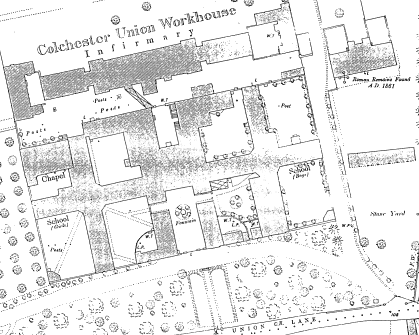
Colchester workhouse site, 1875.
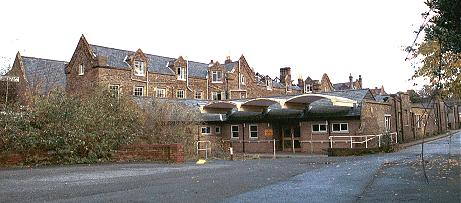
Colchester general view from south-west, 2000.
© Peter Higginbotham.
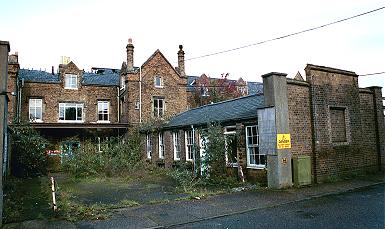
Colchester main block and receiving wards from south, 2000.
© Peter Higginbotham.
A chapel was erected at the west of the site, to the north of the girls' school block.
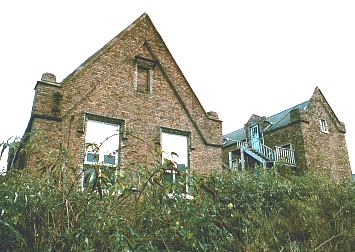
Colchester chapel and girls' school block from west, 2000.
© Peter Higginbotham.
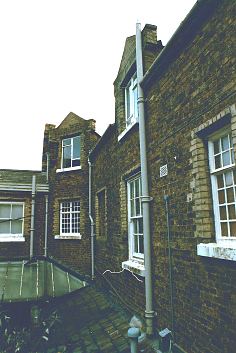
Colchester women's blocks from west, 2000.
© Peter Higginbotham.
The north of the site is dominated by the long infirmary block which was erected in 1848 and later extended several times.
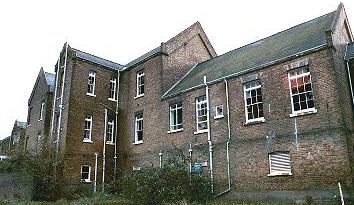
Colchester infirmary block from north-west, 2000.
© Peter Higginbotham.
Later additions included a laundry (1896), casual wards (1898) and a porter's lodge at the south-east of the site, and a new board-room block to the south.
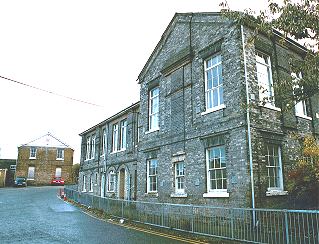
Colchester board-room block (right) and porter's lodge from the west, 2000.
© Peter Higginbotham.
The workhouse later became Colchester Public Assistance Institution, then St Mary's Hospital which closed down in 1993. After a period of standing derelict, the site has now been redeveloped for residential use.
Staff
Inmates
Records
Note: many repositories impose a closure period of up to 100 years for records identifying individuals. Before travelling a long distance, always check that the records you want to consult will be available.
- Essex Record Office, Wharf Road Chelmsford CM2 6YT. Relatively few personal records survive. Holdings include: Guardians' minute books (1835-1930); Deaths of lunatics (1915-2); etc.
Bibliography
- Higginbotham, Peter The Workhouse Encyclopedia (2014, The History Press)
Links
- None.
Unless otherwise indicated, this page () is copyright Peter Higginbotham. Contents may not be reproduced without permission.


